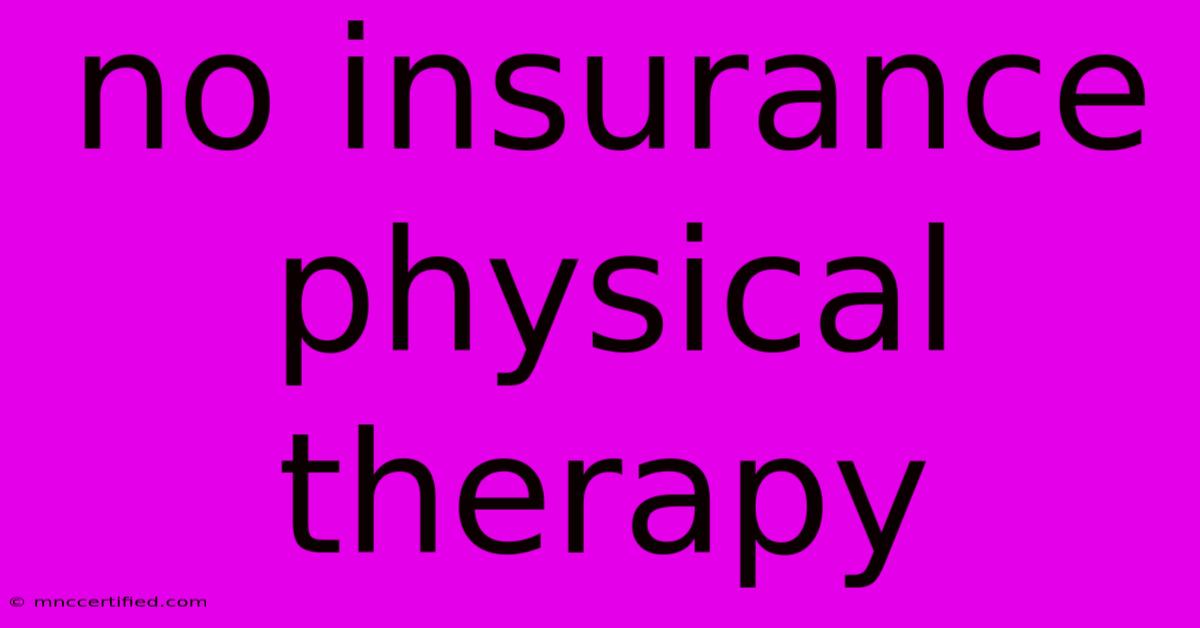No Insurance Physical Therapy

Table of Contents
No Insurance? Accessing Affordable Physical Therapy
Finding yourself needing physical therapy but lacking health insurance can be daunting. The cost of physical therapy can be substantial, leading many to delay or forgo much-needed treatment. However, several options exist to make physical therapy accessible even without insurance. This comprehensive guide explores various avenues to receive affordable physical therapy services.
Understanding the Costs of Physical Therapy Without Insurance
Before exploring options, understanding the potential costs is crucial. Prices vary significantly based on location, the type of therapy needed, and the clinic's pricing structure. A single session can range from $50 to $200 or more, and a course of treatment often requires multiple sessions. Therefore, budgeting and exploring cost-saving strategies are essential.
Factors Influencing Cost:
- Geographic Location: Therapy costs in major metropolitan areas are generally higher than in rural settings.
- Type of Therapy: Specialized therapies, such as manual therapy or aquatic therapy, tend to be more expensive.
- Clinic Type: Private practices may have higher fees than larger clinics or hospital-based outpatient programs.
- Session Length: Longer sessions naturally cost more.
Affordable Physical Therapy Options Without Insurance
Fortunately, several strategies can help you access affordable physical therapy even without insurance coverage:
1. Negotiate Payment Plans and Discounts:
Many physical therapy clinics are willing to work with patients to create payment plans. Don't hesitate to inquire about discounts for cash payments or upfront payments for a series of sessions. Some clinics offer reduced rates for low-income individuals or those facing financial hardship. Always ask!
2. Explore Sliding Scale Fees:
Some non-profit clinics or community health centers offer physical therapy services on a sliding scale based on income. This means the cost of treatment is adjusted to your ability to pay. Research local community resources to find these options.
3. Utilize Free or Low-Cost Clinics:
Several organizations offer free or low-cost healthcare services, including physical therapy. These might be associated with universities, hospitals, or non-profit organizations. Look for medical charities or community health initiatives in your area.
4. Consider Cash-Based Physical Therapy Practices:
Some clinics operate on a cash-only basis, often offering lower rates than those who bill insurance companies. These practices can be more transparent about their pricing, eliminating the complexities of insurance billing.
5. Seek Assistance from Charitable Organizations:
Various charitable organizations provide financial assistance for medical expenses, including physical therapy. Research local and national charities that support healthcare access for low-income individuals.
6. Negotiate with Your Doctor:
If your doctor referred you to physical therapy, consider discussing your financial constraints. They may be able to recommend lower-cost options or assist in finding financial assistance programs.
Finding Affordable Physical Therapy Near You:
Locating affordable options requires research. Utilize these strategies:
- Online Search: Search for "affordable physical therapy [your city/state]" or "cash-based physical therapy [your city/state]".
- Community Resources: Contact local health departments, social service agencies, and community centers for recommendations.
- Doctor Referrals: Your primary care physician or specialist can often provide referrals to clinics with flexible payment options.
Prioritizing Your Health: Don't Delay Treatment
The lack of insurance shouldn't prevent you from receiving necessary physical therapy. By exploring these options and proactively engaging with healthcare providers and community resources, you can find an affordable path to recovery and improved health. Remember, proactive management of your health is crucial, and there are resources available to help you achieve that. Don't delay seeking the care you need.

Thank you for visiting our website wich cover about No Insurance Physical Therapy. We hope the information provided has been useful to you. Feel free to contact us if you have any questions or need further assistance. See you next time and dont miss to bookmark.
Featured Posts
-
Non Owners Insurance Colorado
Nov 29, 2024
-
Live Score Manchester United Vs Bodo Glimt
Nov 29, 2024
-
Bodo Glimt Vs Man Utd Live Match Updates
Nov 29, 2024
-
Insurance Claim Sample Letter
Nov 29, 2024
-
Giants Starting Qb Drew Lock Week 13
Nov 29, 2024